Page path:
Islandinium minutum
Zonneveld, K.A.F. and Pospelova V. (2015). A determination key for modern dinoflagellate cysts. Palynology 39 (3), 387- 409.
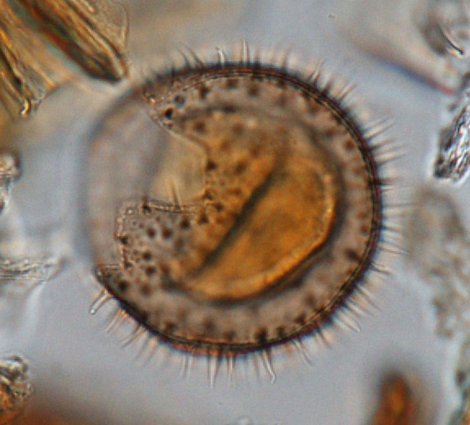
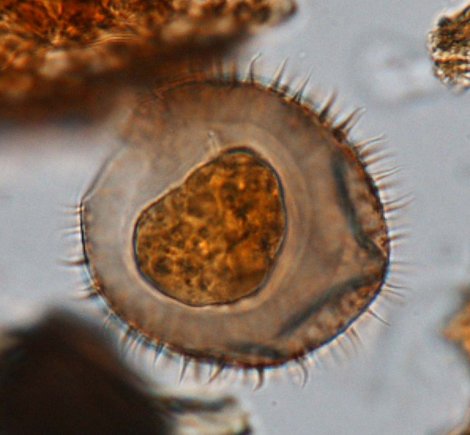
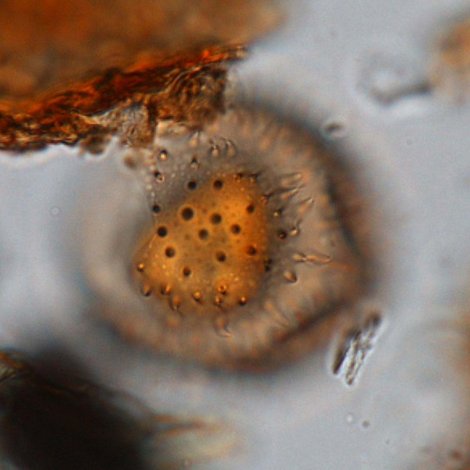
dorsal/laterla view
photograph Vera Pospelova
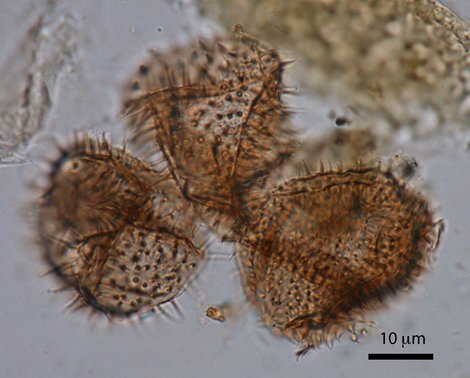
three specimens
cross section
lateral view
Field characteristics
Islandinium minutum (Harland et Reid in Harland et al. 1980) Head et al. 2001.
Characteristics:
Cysts with a spherical body and numerous apparently nontabular processes. Cyst wall always has granulation. Processes are tapering, solid to apiculocavate with acuminate tips. Process basis is circular. The species has a saphopylic apical archeopyle.
Dimensions: Cyst body diameter: 29 to 45 µm; length of processes: 3.5 to 7 µm.
Motile affinity: unknown
Stratigraphic range: recent
Comparison with other species: This species also resembles most closely that of Echinidinium ?cezare. It differs by having acuminate rather than „mushroom-like“ processes.
Characteristics:
Cysts with a spherical body and numerous apparently nontabular processes. Cyst wall always has granulation. Processes are tapering, solid to apiculocavate with acuminate tips. Process basis is circular. The species has a saphopylic apical archeopyle.
Dimensions: Cyst body diameter: 29 to 45 µm; length of processes: 3.5 to 7 µm.
Motile affinity: unknown
Stratigraphic range: recent
Comparison with other species: This species also resembles most closely that of Echinidinium ?cezare. It differs by having acuminate rather than „mushroom-like“ processes.
Geographic distribution
Geographic distribution based on:
Zonneveld et al., 2013. Atlas of modern dinoflagellate cyst distribution based on 2405 datapoints. Review of Palaeobotany and Palynology, v. 191, 1-197
Islandinium minutum is a temperate to polar species with a bipolar distribution. Highest relative abundances are found in polar regions where surface waters do not exceed 0°C in winter and surface water salinity can be reduced due to melting of ice. It is present in oligotrophic to eutrophic environments where anoxic to well ventilated bottom water conditions can occur.
Zonneveld et al., 2013. Atlas of modern dinoflagellate cyst distribution based on 2405 datapoints. Review of Palaeobotany and Palynology, v. 191, 1-197
Islandinium minutum is a temperate to polar species with a bipolar distribution. Highest relative abundances are found in polar regions where surface waters do not exceed 0°C in winter and surface water salinity can be reduced due to melting of ice. It is present in oligotrophic to eutrophic environments where anoxic to well ventilated bottom water conditions can occur.
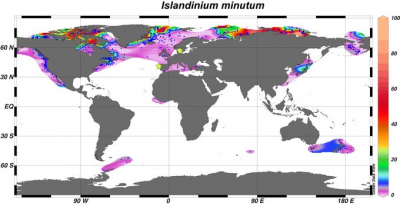
Distribution:
Islandinium minutum has a bipolar distribution restricted to temperate to polar regions. Exception is given by two occurences of the species in the coastal eastern equatorial Atlantic Ocean. Abundances up to 97% can be observed in arctic polar waters. It has high relative abundances in regions where large seasonal contrasts exist. It can be observed in coastal sites as well as in the central oceans.
Environmental parameters:
SST: -2.1 - 29.3°C (winter - summer), SSS: 6.7 - 38.1 (summer - autumn), [P]: 0.10 - 1.73 μmol/l, [N]: 0.01 - 26.2 μmol/l, chlorophyll-a: 0.01 - 20.8 ml/l, bottom water [O2]: 0.3 - 8.2 ml/l.
Abundances > 10% occur where temperatures are < 0°C in winter and < 5.0°C in summer. A positive relationship between cyst abundance and decreasing SST can be observed. The species is present in regions where salinities can be seasonally strongly reduced as a result of melting of snow and ice. High relative abundances occur in high nutrient - low productivity regions.
Comparison with other records:
Apart from observations included in this atlas, I. minutum is documented off the northern part of the Iberian Peninsula and in Swedish fjords (Sprangers et al., 2004; Harland et al., 2004). In sediment trap records from the Weddell and Scotia Seas I. minutum forms a prominent part of the total cyst flux in sites that are located south of the maximal winter ice extension whereas it is absent in trap samples from sites north of this boundary (Harland and Pudsey, 1999). It occurs in offshore and inshore sediments of Svalbard (Grøsfjeld et al., 2009) In an arctic fjord of northern Svalbard production of this species occurs in late May, June when temperatures in the Fjord rise (Howe et al., 2010). Its occurence is associated with the presence of Arctic Water in this location.
In arctic regions the relative abundances of this species increase linearly with the duration of seasonal sea ice cover and it can be observed in high abundances in sites that can be covered by sea ice up to 12 months a year (de Vernal et al., 1998; Radi and de Vernal, 2008)
Islandinium minutum has a bipolar distribution restricted to temperate to polar regions. Exception is given by two occurences of the species in the coastal eastern equatorial Atlantic Ocean. Abundances up to 97% can be observed in arctic polar waters. It has high relative abundances in regions where large seasonal contrasts exist. It can be observed in coastal sites as well as in the central oceans.
Environmental parameters:
SST: -2.1 - 29.3°C (winter - summer), SSS: 6.7 - 38.1 (summer - autumn), [P]: 0.10 - 1.73 μmol/l, [N]: 0.01 - 26.2 μmol/l, chlorophyll-a: 0.01 - 20.8 ml/l, bottom water [O2]: 0.3 - 8.2 ml/l.
Abundances > 10% occur where temperatures are < 0°C in winter and < 5.0°C in summer. A positive relationship between cyst abundance and decreasing SST can be observed. The species is present in regions where salinities can be seasonally strongly reduced as a result of melting of snow and ice. High relative abundances occur in high nutrient - low productivity regions.
Comparison with other records:
Apart from observations included in this atlas, I. minutum is documented off the northern part of the Iberian Peninsula and in Swedish fjords (Sprangers et al., 2004; Harland et al., 2004). In sediment trap records from the Weddell and Scotia Seas I. minutum forms a prominent part of the total cyst flux in sites that are located south of the maximal winter ice extension whereas it is absent in trap samples from sites north of this boundary (Harland and Pudsey, 1999). It occurs in offshore and inshore sediments of Svalbard (Grøsfjeld et al., 2009) In an arctic fjord of northern Svalbard production of this species occurs in late May, June when temperatures in the Fjord rise (Howe et al., 2010). Its occurence is associated with the presence of Arctic Water in this location.
In arctic regions the relative abundances of this species increase linearly with the duration of seasonal sea ice cover and it can be observed in high abundances in sites that can be covered by sea ice up to 12 months a year (de Vernal et al., 1998; Radi and de Vernal, 2008)


